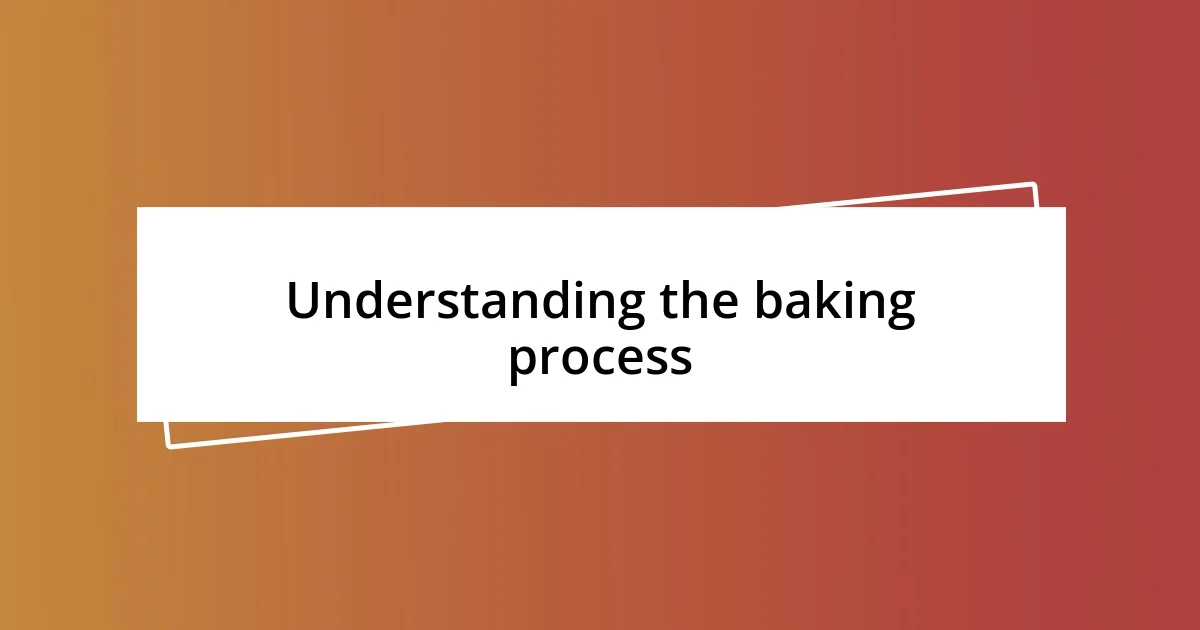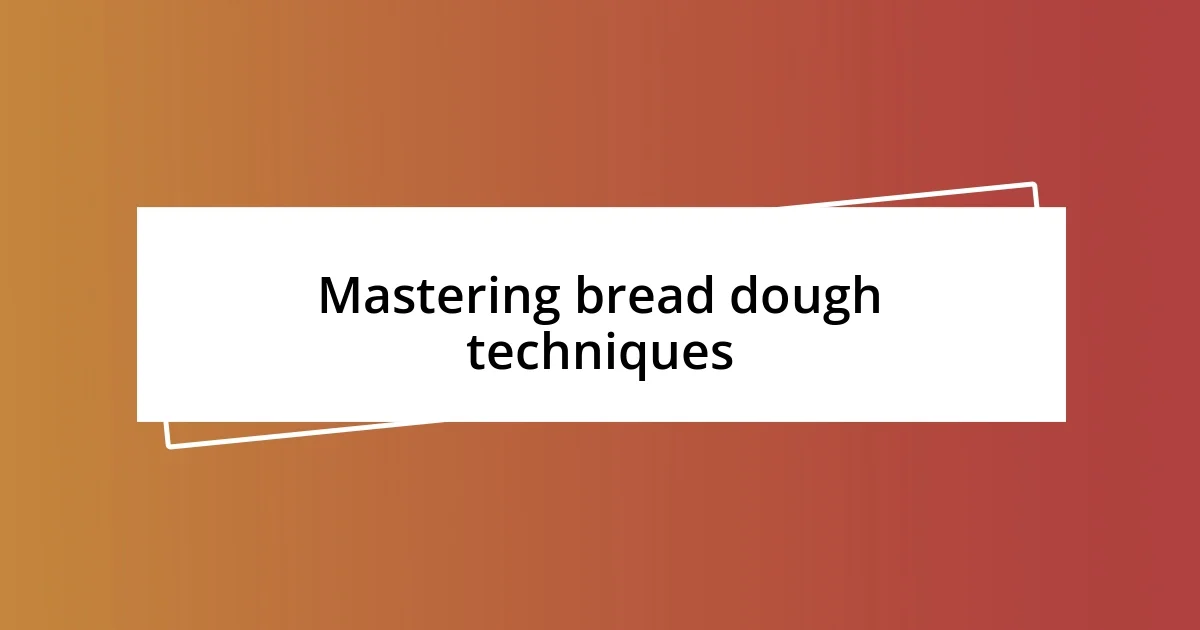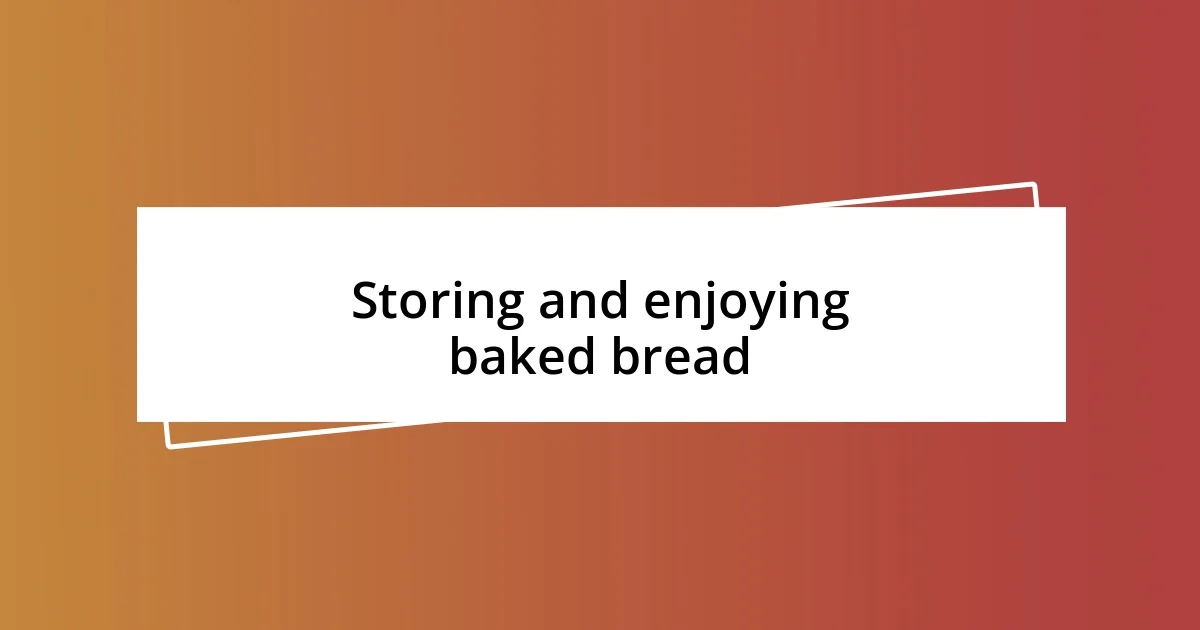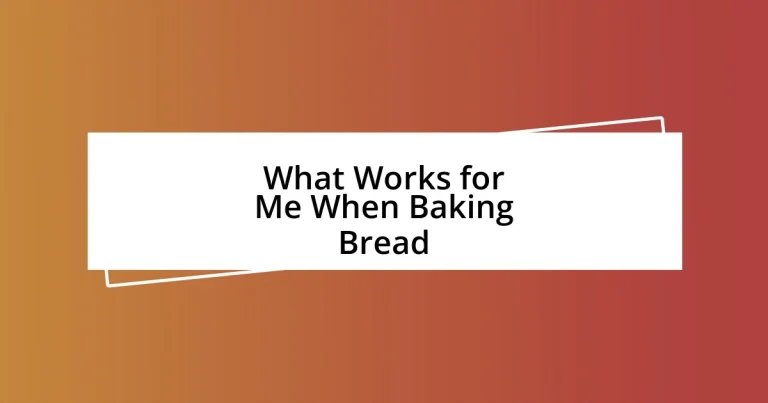Key takeaways:
- Baking bread is a transformative process that requires patience, proper ingredient selection, and attention to techniques like kneading, temperature, and shaping for the best results.
- Utilizing optimal baking methods, such as high temperatures and steam, as well as monitoring internal temperatures, ensures a perfect rise and crust for the bread.
- Proper storage and creative enjoyment of bread enhances its freshness and allows for delightful meals, while sharing baked goods fosters connections with others.

Understanding the baking process
Baking bread is more than just mixing ingredients; it’s a transformative process. I often find myself fascinated by how simple elements like flour, water, yeast, and salt come together to create something beautiful and nourishing. Have you ever noticed the way the dough changes texture after kneading? It’s almost like watching a magic trick unfold right in your kitchen.
Fermentation is another critical stage that I’ve come to appreciate. When the yeast ferments the sugars, it releases carbon dioxide, causing the dough to rise. I remember one evening when I got impatient and rushed this step. The result? A flat loaf that didn’t do justice to the effort I had put in. It taught me that patience truly pays off in the world of baking.
Finally, the baking part is where the science meets art. The moment I slide the dough into the oven, the anticipation is palpable. I’ve learned to watch for that golden crust and listen for the crackling sound that tells me my bread is alive and well. How satisfying is it to open the oven door to a perfectly baked loaf? That experience is a reminder that every step in the process plays a crucial role, turning just simple ingredients into something extraordinary.

Choosing the right ingredients
Choosing the right ingredients sets the foundation for wonderful bread. I’ve learned the hard way that not all flours are created equal. Each type brings unique characteristics; for instance, bread flour has a higher protein content, leading to more structure in your loaf. One time, I made a batch using all-purpose flour on a whim, and while it was edible, it lacked that sought-after chewiness. The experience reinforced the idea that investing time in ingredient selection is always worth it.
When it comes to baking, here’s the breakdown of essential ingredients that I always consider:
- Flour: Choose a high-protein flour, like bread flour, for a sturdy structure.
- Water: Use filtered water; tap water can have chlorine, which may hinder yeast activity.
- Yeast: Active dry yeast is my go-to for consistency, but fresh yeast can be fun if you can find it.
- Salt: Don’t skimp here! Salt enhances flavor and strengthens gluten.
- Optional Add-ins: I love experimenting with herbs, seeds, or a splash of olive oil for added flavor.

Mastering bread dough techniques
Mastering bread dough techniques can be a game-changer in your baking journey. One technique I find invaluable is proper kneading. Initially, I didn’t quite understand how to knead effectively, often underestimating its importance. I remember the first time I really worked that dough, feeling the gluten develop into a smooth ball under my hands. The transformation was incredible! It taught me that kneading isn’t just about mixing; it’s about activating the proteins to create that beautiful elasticity, which is essential for a delightful bread texture.
Another aspect worth mentioning is the significance of dough temperature. I always check the warmth of my ingredients because a cold dough can hinder yeast activity. I’ve had my share of disappointments when I forgot to warm my water on a chilly day. The dough struggled to rise, leaving me staring at a flat disappointment. Now, I take the time to ensure everything is at the right temperature, allowing the yeast to thrive, and my patience has been rewarded with perfect loaves every time.
Finally, mastering the art of shaping dough is crucial for consistent results. I often find joy in the final shaping, turning the dough into a loaf or rolls. The technique can affect the final look and crumb structure, so precision matters. I still recall shaping a braided loaf for a gathering; the sight of that beautifully entwined bread felt like a labor of love. It’s those little moments in dough handling that elevate the baking experience, connecting me to the food I create.
| Technique | Description |
|---|---|
| Kneading | Develops gluten structure for better texture. |
| Dough Temperature | Ensures optimal yeast activity for rising. |
| Shaping | Finalizes the loaf structure and visual appeal. |

Safely using yeast and fermentation
Using yeast safely is crucial for any bread baking enthusiast. I remember the first time I handled yeast; I was so cautious, fearing that I might ruin the entire batch. It’s important to pay attention to expiration dates, as expired yeast can lead to disappointing rises. Always activate it by dissolving it in warm water, ideally around 105°F to 110°F (38°C to 43°C). I find it’s almost like waking the yeast up from a slumber, and the gentle fizzing is a rewarding sound that signals it’s alive and ready to work!
Fermentation is where the magic truly happens, and I’ve come to appreciate its role over time. I often let my dough rise in a warm area, covered with a damp cloth, which not only prevents drying but also creates a cozy environment. One time, I placed a bowl of dough near a sunny window and got carried away with my chores. Later, I returned to find my dough bursting out of the bowl! It was a sight that made my heart race and reminded me just how alive and energetic properly fermented dough can be. That experience taught me to keep a watchful eye—after all, timing is everything in baking!
Finally, understanding how to manage fermentation duration can make a world of difference. I’ve played around with both shorter and longer rises, and I find that longer fermentation often leads to richer flavors. Have you noticed how some artisanal breads have a depth that’s hard to achieve in a rush? The time spent waiting can be agonizing, but the delightful aroma filling your kitchen while the dough works is incredibly rewarding. I now intentionally plan my bakes, allowing for that slow rise that imparts character to my bread.

Perfecting shaping and scoring bread
When it comes to shaping my bread, I’ve learned that technique matters just as much as ingredients. I still remember the first time I attempted to shape a sourdough loaf; my fingers fumbled, and the dough felt rebellious, sticking to my hands instead of behaving nicely. Now, I find that a little bench flour and gentle pressure can make a world of difference. The way you shape the dough not only influences its final appearance but also helps structure the crumb, leading to that perfect texture we all love.
Scoring the dough might seem like a minor step, but it’s where creativity truly shines for me. I once had a loaf that I neglected to score before baking, and it erupted with an unsightly tear instead of the lovely bloom I was aiming for. Now, I approach scoring like an artist—each slash is a stroke that tells a story. The aesthetic appeal is important, but the function is equally critical; scoring allows the bread to expand properly in the oven, leading to a better rise. What patterns do you love to create? I’ve been experimenting with different designs, from simple lines to intricate patterns, and it adds an exciting personal touch to each loaf.
Finding the right technique can feel like an ongoing journey, but I cherish those moments when the dough transforms under my hands. I often think of shaping and scoring as a meditation; there’s a unique satisfaction in coaxing the dough into a beautiful form and then letting it release its potential in the bake. So, next time you’re at the bench, remember—it’s not just bread; it’s a canvas awaiting your artistic expression!

Optimal baking methods and temperatures
When it comes to baking bread, I’ve discovered that the method and temperature are pivotal. I usually preheat my oven to around 450°F (232°C) for most artisan loaves. This high heat encourages a great oven spring, giving my bread that beautiful rise and crust that I crave. I love the way my kitchen fills with warmth and anticipation as I wait, knowing that the bread will soon transform. Have you ever watched dough morph into a golden masterpiece? It really is something special!
Using steam in the first part of baking has become a game-changer for me. I remember the first time I experimented with adding a pan of hot water in the oven; the difference was astounding! The steam keeps the outer layer of the dough moist, allowing it to expand and develop that delightful crust. Now, I can’t bake without my little steam trick; it’s like giving the bread a warm hug before it hits the heat. How do you think your bread would change with that added moisture?
Lastly, I pay close attention to the internal temperature of my bread once it’s done baking. I’ve found that the ideal internal temperature is around 190°F to 200°F (88°C to 93°C). It took me a few attempts to get the hang of this, but monitoring with a kitchen thermometer has saved me from underbaked disasters. The sound of a hollow thump when I tap the bottom of the loaf tells me I’ve achieved that perfect bake. Who knew a simple thermometer could make such a difference? That feeling of slicing into a loaf that’s perfectly cooked makes all my efforts worthwhile!

Storing and enjoying baked bread
Once my bread is out of the oven and cooled, I always make sure to store it properly to enjoy that fresh-baked taste for a little longer. I remember the first time I left a loaf uncovered overnight; by morning, it was staler than I could bear! Now, I wrap my bread in a clean kitchen towel and place it in a breadbox or an airtight bag. This method keeps the crust nice and crunchy while preserving the soft interior. Have you ever experienced the satisfaction of tearing into a still-fresh loaf days later? It’s a little victory worth striving for.
When it comes to enjoying my bread, I like to get creative. There’s nothing quite like a simple slice of warm bread with butter melting into it, but sometimes I indulge in making a lavish bruschetta or a hearty sandwich. Just the other day, I piled my homemade bread high with roasted veggies and a drizzle of balsamic glaze. It made for a colorful and surprisingly gourmet lunch! What’s your favorite way to savor fresh bread? It’s fascinating how something so foundational can elevate a meal into something extraordinary.
I’ve also learned the joy of sharing my baked creations. There’s a special warmth that comes from presenting a freshly baked loaf to friends or family. A few weekends ago, I took a warm sourdough to a small gathering, and seeing them tear into it, savoring every bite, created a sense of community that made my heart swell. Bread isn’t just something I make; it’s an experience to be relished with loved ones. Have you thought about how simple acts like breaking bread together can forge connections? It’s truly wonderful!














